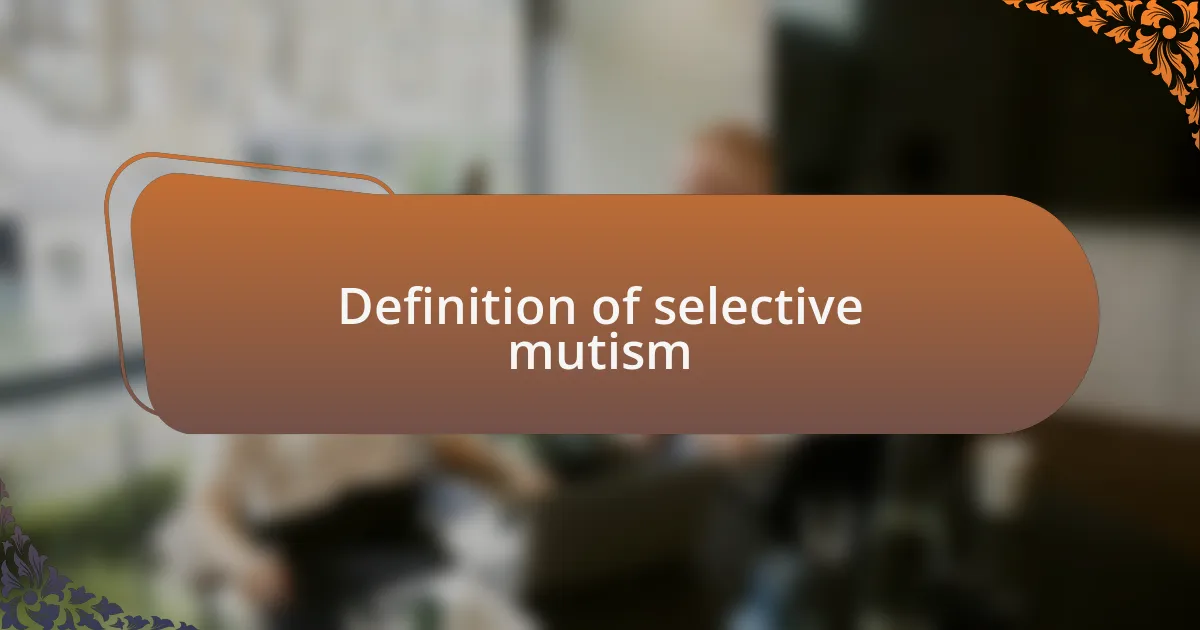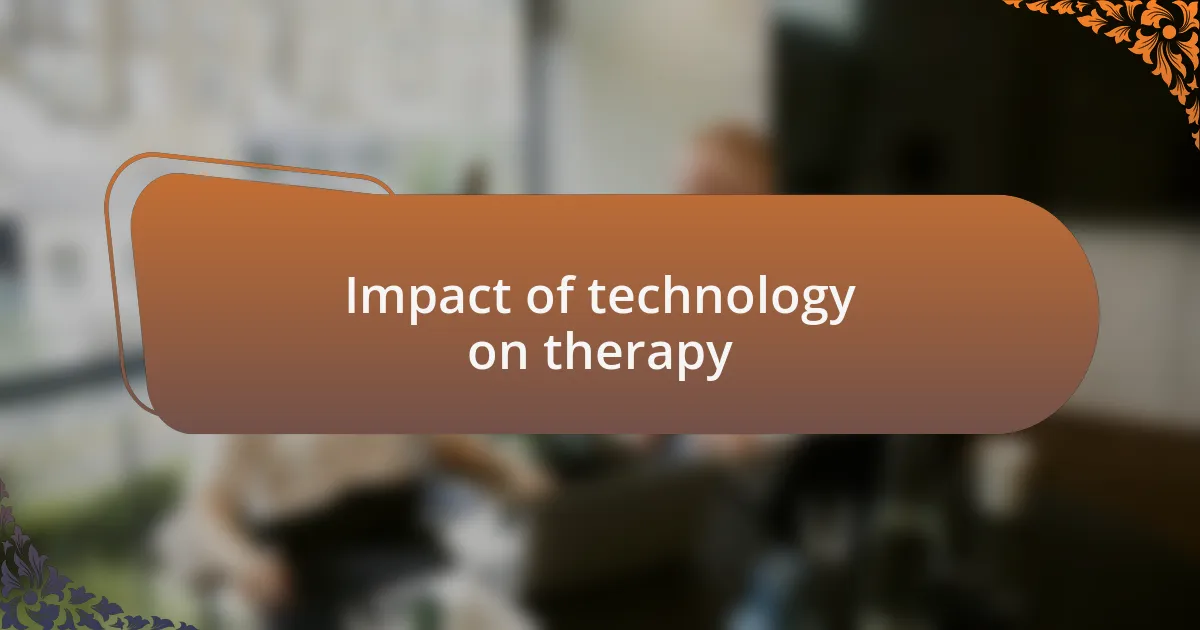Key takeaways:
- Selective mutism is an anxiety disorder that prevents children from speaking in certain social situations, often misunderstood as mere shyness.
- Raising awareness about selective mutism fosters understanding and creates supportive environments that encourage communication.
- Technology, such as virtual therapy and mobile apps, has enhanced therapy for selective mutism, providing accessible and flexible support for children.
- Incorporating mindfulness, art therapy, and play-based activities can significantly benefit therapy outcomes by fostering self-expression and reducing anxiety.

Definition of selective mutism
Selective mutism is a complex anxiety disorder that primarily affects children, inhibiting their ability to speak in certain social situations despite having the capacity to do so in more comfortable environments. I remember a time when a friend’s child, who was generally chatty at home, became almost invisible in a classroom setting, not uttering a word while surrounded by peers. This stark change can be both puzzling and heartbreaking for families, as it’s often misunderstood as shyness when it can be so much deeper.
At its core, selective mutism manifests as an overwhelming fear that traps the individual in silence, leaving them feeling isolated and misunderstood. I’ve seen how crucial it is for parents and caregivers to recognize these signs early; through my experience, I can say that patience and understanding can often help create a safe space for a child to open up. Have you ever felt like you had something important to say but just couldn’t find the words? That’s a glimpse into the daily struggle faced by those living with selective mutism.
The condition is not a refusal to speak; rather, it’s an intense anxiety that can make verbal communication feel impossible. I once spoke with a young adult who shared that the anxiety she faced in social settings was so paralyzing that words would simply vanish. It’s a reminder that we need to approach this topic with compassion, striving to bridge the gap between silence and speech in supportive, understanding ways.

Importance of selective mutism awareness
Selective mutism awareness is crucial for fostering understanding and compassion in both schools and communities. I remember when my neighbor’s son struggled in group activities, his silence often mistaken for disinterest. How many opportunities for friendship or support are lost simply because others don’t recognize the signs? When people understand that selective mutism stems from anxiety, they can better empathize, creating an environment that encourages communication instead of misunderstanding.
Moreover, raising awareness helps families feel less isolated in their journey. During a community event, I connected with parents who were navigating similar challenges, sharing our stories and strategies. It became clear that awareness not only provides valuable insights but also builds a support network, reminding families that they are not alone. How freeing is it to know that shared experiences can lead to collective strength?
Lastly, understanding selective mutism can significantly influence treatment approaches and outcomes. For instance, I once attended a workshop where professionals emphasized the importance of tailored strategies that cater to each child’s needs. This kind of targeted support can empower children, helping them to gradually find their voice in safe and nurturing settings. If we can shift public perception, we open doors to healing and growth, transforming silence into reassurance.

Impact of technology on therapy
The role of technology in therapy has transformed the way many of us approach selective mutism. I recall a recent experience where a therapist introduced me to virtual therapy tools. Initially, I was skeptical, wondering if a screen could truly foster the same connection as face-to-face interactions. Yet, I quickly discovered that these platforms allowed for more flexibility, enabling children to engage in low-pressure environments where they felt safer. Isn’t it fascinating how a simple shift in medium can lead to such a profound impact on therapeutic outcomes?
Mobile apps and online resources have also become essential companions in the journey of overcoming selective mutism. I remember downloading an anxiety management app for my own use, which provided soothing exercises and progress tracking features. The ability to access support at any time, right from a smartphone, really highlights a sense of empowerment. Have you ever thought about how these tools can act as a bridge, connecting children to the strategies they need when in-person sessions may not always be feasible?
Furthermore, social media has played a pivotal role in fostering community and support among families dealing with selective mutism. I often find myself engaging with online groups where parents share successes and challenges, creating a sense of belonging. Through these platforms, insights and resources are exchanged, breaking down barriers of isolation. How comforting it feels to find others who truly understand your experiences! In many ways, technology not only enhances therapy but also cultivates connections that nurture emotional well-being.

Personal experiences with new trends
I can’t help but reflect on how incorporating mindfulness practices into therapy has altered my approach. A therapist once introduced me to guided meditation sessions, which seemed unconventional at first. Initially, I was hesitant to sit quietly and focus, but to my surprise, it opened a new door for understanding my anxiety better. Could something so simple really change how we respond to stressors? It did for me.
Moreover, I’ve recently explored art therapy, which has been a revelation. I remember an afternoon spent drawing while discussing my feelings related to selective mutism. Painting became my voice when words failed me. This creative outlet allowed me to express emotions I often struggled to articulate. Isn’t it incredible how colors and shapes can convey complex feelings?
Lastly, I’ve seen firsthand how incorporating play-based activities in therapy can reshape interactions. I recall a session where we used toys to role-play social situations, helping to ease the tension that often comes with these scenarios. This playful approach enabled me to practice communication in a stress-free environment, making it feel less daunting. Have you noticed how play can sometimes ignite a spark of connection that typical conversations might not?